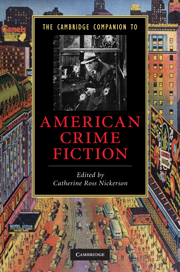Book contents
- Frontmatter
- 1 Introduction: The satisfactions of murder
- 2 Early American crime writing
- 3 Poe and the origins of detective fiction
- 4 Women writers before 1960
- 5 The hard-boiled novel
- 6 The American roman noir
- 7 Teenage detectives and teenage delinquents
- 8 American spy fiction
- 9 The police procedural in literature and on television
- 10 Mafia stories and the American gangster
- 11 True crime
- 12 Race and American crime fiction
- 13 Feminist crime fiction
- 14 Crime in postmodernist fiction
- Guide to reading
- Index
13 - Feminist crime fiction
Published online by Cambridge University Press: 28 September 2010
- Frontmatter
- 1 Introduction: The satisfactions of murder
- 2 Early American crime writing
- 3 Poe and the origins of detective fiction
- 4 Women writers before 1960
- 5 The hard-boiled novel
- 6 The American roman noir
- 7 Teenage detectives and teenage delinquents
- 8 American spy fiction
- 9 The police procedural in literature and on television
- 10 Mafia stories and the American gangster
- 11 True crime
- 12 Race and American crime fiction
- 13 Feminist crime fiction
- 14 Crime in postmodernist fiction
- Guide to reading
- Index
Summary
“For women to find a voice, a voice telling them that they may have adventures, that action is a woman's appropriate sphere, has been the difficult task of the last several centuries.”
This is the story of a feminist counter-tradition in the crime and mystery fiction genre, and the story of that counter-tradition's impact. The late 1970s and early 1980s saw American writers Marcia Muller, Sue Grafton and Sara Paretsky, independently of each other, each creating a female private eye/ investigator character; all three novelists subsequently developed commercially successful and popular series based on their mold-breaking female private eye creations. Positioned at the center of the narrative, in the familiar first-person voice of the hard-boiled tradition embodied by Chandler's Philip Marlowe, characters such as Sharon McCone, Kinsey Millhone, and V. I. Warshawski were allowed agency, intelligence and action. These were pioneering constructions of the modern female detective figure; as more women writers featuring strong central women characters came on board throughout the 1980s and 1990s, from both the USA and the UK, a range of feminist sensibilities came to bear on the genre, and it has never looked back. Now, at the end of the first decade of the twenty-first century, it is not only safe to say, but perhaps imperative to understand, that crime and mystery fiction really has not been the same since the birth of these three gumshoes, and many more like them.
- Type
- Chapter
- Information
- The Cambridge Companion to American Crime Fiction , pp. 148 - 162Publisher: Cambridge University PressPrint publication year: 2010
- 5
- Cited by



